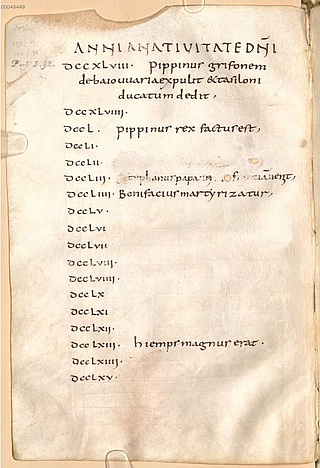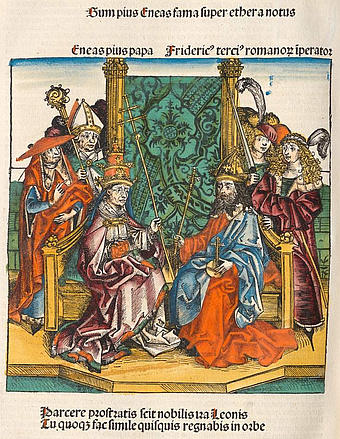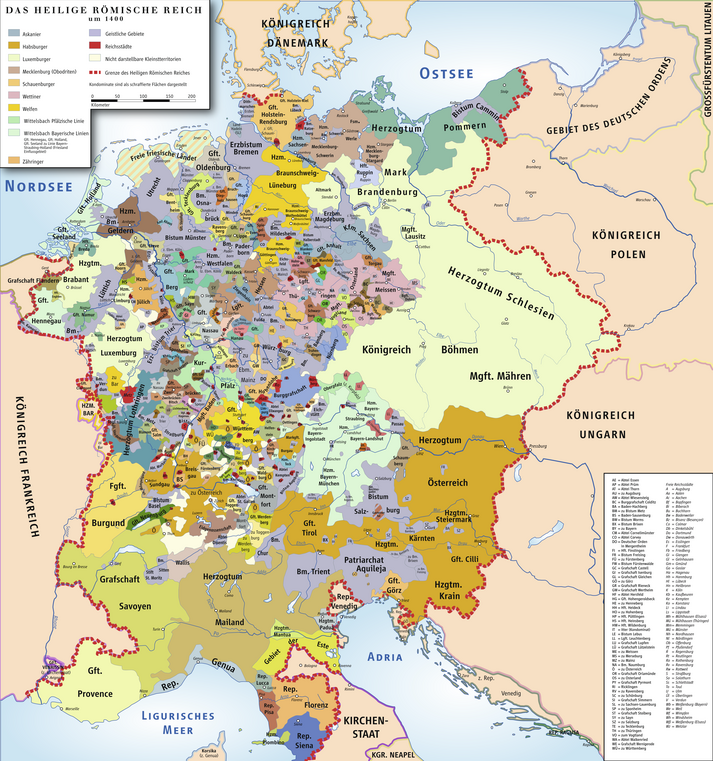Which Sources does the Repertorium include?
In the words of the still valid definition of historian Paul Kirn (1890-1965), historical sources are „all texts, objects or facts from which knowledge of the past can be gained”.

To satisfy this definition, our Repertorium would have to encompass an almost unlimited number of historical source materials, including archaeological finds, texts, art objects of all sorts, place names, and proverbs. Unfortunately, the scale and diversity of such an undertaking exceeds the resources of a single research project. We are thus obliged to significantly limit the scope of our coverage:
Only Texts
Firstly, the Repertorium is restricted to written source material. Our texts are almost exclusively transmitted in manuscripts, such as the Carolingian Annals of St. Emmeram in Regensburg, written 800/900 AD, depicted here to the right (see the corresponding Repertorium entry in:
www.geschichtsquellen.de (Opus 368).

Historical sources first began to appear in printed form in the late 15th century after the invention of the printing press. However, printing was only economically viable for works of general interest: This was rarely the case with historical accounts. A very beautiful example of a printed historical work is the so-called “Schedelsche Weltchronik” of 1493 depicted to the left,
cf. www.geschichtsquellen.de (Opus 4188).
Works of historical remembrance
Secondly, the Repertorium is mainly concerned with texts that were initially conceived and written with the intent of preserving historical remembrance, i.e. historiographical works in a narrower sense. Besides these, the Repertorium also encompasses texts such as letters, political treatises, legal texts, etc. By contrast, formalised documents such as charters and rent-rolls, inscriptions, and texts with a predominantly serial character or of purely religious or literary content are generally not included.
Written Between 750 and 1500
Thirdly, the Repertorium documents the Medieval history of the Holy Roman Empire with an approximate time-frame from 750 AD to 1500 AD, beginning with the rise to power of the Carolingians in the Frankish realm and ending with the reign of Emperor Maximilian I (†1519). Correspondingly, the Repertorium encompasses historiographical source material from the entire Frankish Realm until the end of the ninth century (i.e. including the later French Kingdom) and thereafter only from the East Frankish and German regions.
With the focus on the Holy Roman Empire
Finally, the focus on the Medieval Holy Roman Empire also delineates the geographical base of our source material. This area was considerably larger than that of the present-day Federal Republic of Germany, including the territories of the Netherlands and Belgium, Lorraine and Alsace, Switzerland, Austria, Bohemia, Silesia, and Pomerania. External sources are, however, taken into account if they are closely connected to German history, such as texts on the Teutonic Order in the Baltic lands, German kings in Italy, or the relationship between the Empire and the Papacy.

